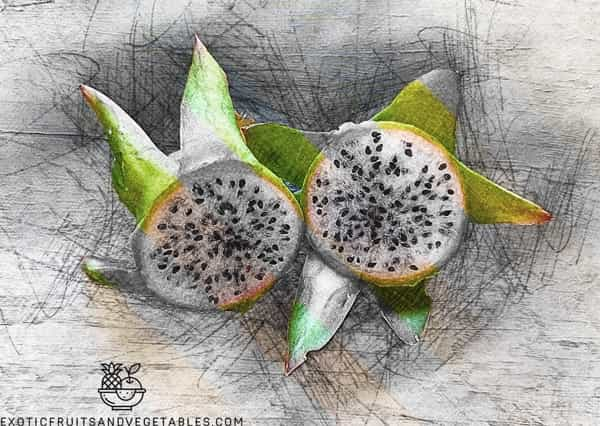Bruni dragon fruit is a hybrid variety of the cactus plant, with its origins stemming from the Hylocereus stenopterus and Hylocereus undatus species. This variety was created by German hybridizer Eckhard Meier and is one of three hybrid clones, with the other two being Connie Mayer and Kathie Van Arum.
Description
Bruni dragonfruit is known for its unique taste, beautiful appearance, and high yield, making it a popular choice for growers and consumers alike. One of the most attractive features of this sort is its appearance. The fruit is oval-shaped, and the skin is a bright green color with lemon-lime scales. The scales give the fruit a unique, almost alien-like appearance, making it stand out from other fruits.
Origin: California Peel color: Peach and its fins are lime green Flesh color: White Brix: ~18-22 Pollination: Self-Sterile Growth rate: 4 out of 5 Fruit production: 4 out of 5 Flavor: 5 out of 5 Commercial planting: 4 out of 5
When cut open, the flesh of the fruit is white with small black seeds throughout. The fruits are small and weigh between 0.25 and 0.75 pounds. The fruit gets sweeter the longer it stays on the plant. How does it taste? It tastes great! Most dragon fruit do! It tastes like coconut and lemon.
This pitahaya is also known for its high yield. This variety produces an abundance of fruit, with each plant producing up to 50-60 fruits per year. The flower is about the size of a fist, with purple inner petals that fade to light pink edges and white tips.
Even before the flower opens, the flower bud is beautiful. The flower blooms at night and closes in the morning. Compared to other kinds, this one comes out much earlier. Bruni is self-sterile. For the flowers of this variety to make fruit, you will need a different variety to pollinate them.

Another notable feature of this dragon fruit is its adaptability to various growing conditions and soils. This variety is suitable for both indoor and outdoor cultivation and can grow in a range of soils, including sandy or loamy soils. Bruni pitaya also prefers warm temperatures, making it ideal for tropical or subtropical climates.
The Enchanting Enigma: My Bruni Dragon Fruit Journey
For years, my farm has been a canvas of magenta and ruby red, bursting with the vibrant hues of the traditional red-fleshed dragon fruit. But a few seasons ago, curiosity, that insatiable itch for every green thumb, led me down a path less traveled – the enigmatic Bruni. This green-skinned beauty with a heart of white flesh promised a flavor profile unlike any other, and let me tell you, it did not disappoint.
Growing Bruni was an adventure from the start. Unlike its red cousins, which thrive on readily available cuttings, Bruni is a bit of a prima donna. Seeds are the only way to go, and even then, germination rates can be finicky. It took weeks of meticulously monitoring moisture levels and temperatures before I saw those first, fragile green shoots emerge. It was like witnessing the birth of a mythical creature – a tiny testament to perseverance.
As the seedlings matured, their growth mirrored that of a shy teenager. They weren’t flamboyant or fast-growing, but there was a quiet determination in their slow and steady climb. Unlike the red varieties that sprawl wildly, Bruni has a more controlled, columnar growth habit. This meant I could space my plantings closer together, maximizing my harvest potential – a welcome change for a space-conscious farmer like myself.

The wait for the fruit was agonizingly sweet. But patience, as always, is a farmer’s virtue. And when those first green orbs finally began to swell, a sense of accomplishment washed over me. Watching them transform from pea-sized bumps to the size of grapefruits was a daily source of wonder. The green skin, dappled with subtle white speckles, had a smooth, almost waxy texture that felt cool to the touch. It was unlike anything I’d ever encountered before.
Then came the moment of truth – the harvest. With bated breath, I sliced into the first fruit. The flesh, a pristine white, held none of the vibrant pink hues of its red relative. But the aroma that wafted up was pure enchantment – a complex blend of floral notes and a hint of tropical sweetness. The first bite was a revelation. It was juicy, yet refreshingly light, with a subtle sweetness that lingered on the palate. It wasn’t the explosion of flavor you get from the red dragon fruit, but a more nuanced, delicate dance on the taste buds.
The Bruni has become the star attraction at my farmer’s market stall. People are initially drawn by its unusual appearance, then captivated by its unique flavor. It’s a conversation starter, a chance to introduce folks to the wonders of the dragon fruit world beyond the standard red.
Growing Bruni is not for the faint of heart. It requires patience, a touch of finesse, and a willingness to embrace the unexpected. But for those willing to take the challenge, the reward is a truly extraordinary fruit – a testament to the hidden gems that await discovery in the world of agriculture. So, if you’re looking for an adventure, and a taste unlike any other, then I urge you to give the Bruni dragon fruit a try. You might just be surprised by the magic it weaves.
Conclusion
In conclusion, Bruni dragon fruit is a unique and attractive variety that offers both delicious taste and high yield. Its adaptability to different growing conditions and soils makes it an excellent choice for growers, while its distinctive appearance and taste make it a favorite among consumers.








